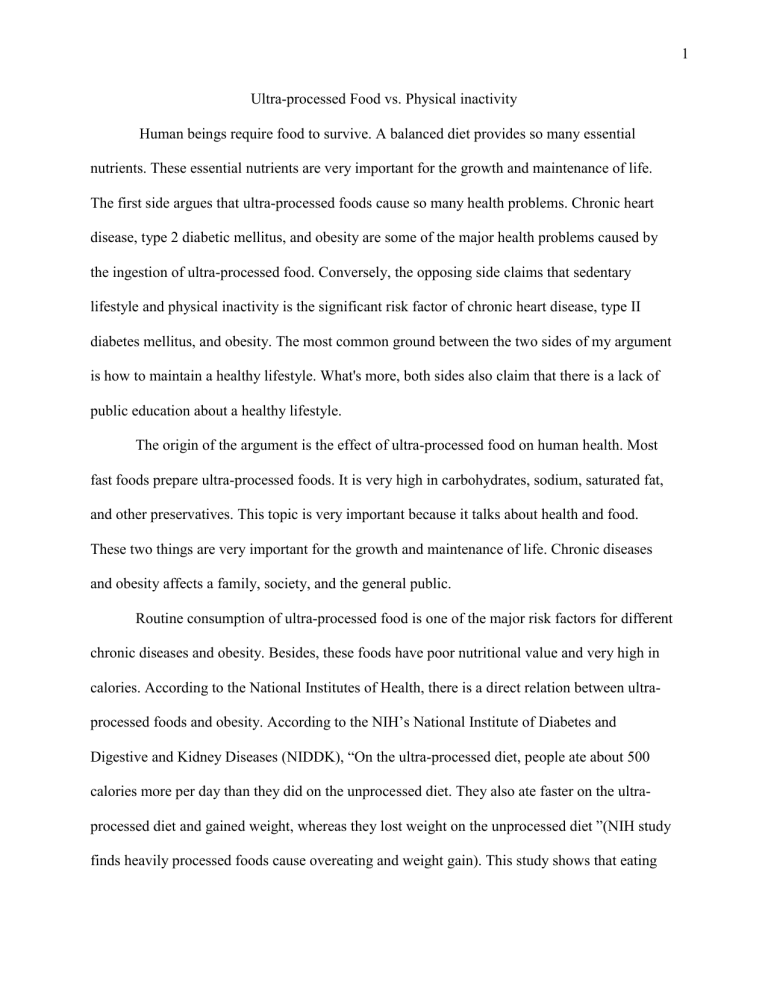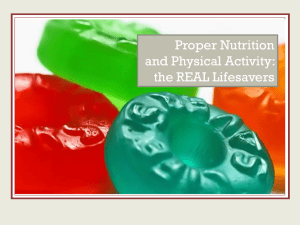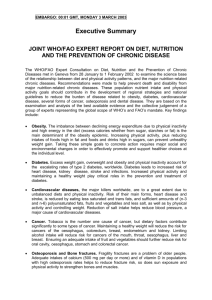
1 Ultra-processed Food vs. Physical inactivity Human beings require food to survive. A balanced diet provides so many essential nutrients. These essential nutrients are very important for the growth and maintenance of life. The first side argues that ultra-processed foods cause so many health problems. Chronic heart disease, type 2 diabetic mellitus, and obesity are some of the major health problems caused by the ingestion of ultra-processed food. Conversely, the opposing side claims that sedentary lifestyle and physical inactivity is the significant risk factor of chronic heart disease, type II diabetes mellitus, and obesity. The most common ground between the two sides of my argument is how to maintain a healthy lifestyle. What's more, both sides also claim that there is a lack of public education about a healthy lifestyle. The origin of the argument is the effect of ultra-processed food on human health. Most fast foods prepare ultra-processed foods. It is very high in carbohydrates, sodium, saturated fat, and other preservatives. This topic is very important because it talks about health and food. These two things are very important for the growth and maintenance of life. Chronic diseases and obesity affects a family, society, and the general public. Routine consumption of ultra-processed food is one of the major risk factors for different chronic diseases and obesity. Besides, these foods have poor nutritional value and very high in calories. According to the National Institutes of Health, there is a direct relation between ultraprocessed foods and obesity. According to the NIH’s National Institute of Diabetes and Digestive and Kidney Diseases (NIDDK), “On the ultra-processed diet, people ate about 500 calories more per day than they did on the unprocessed diet. They also ate faster on the ultraprocessed diet and gained weight, whereas they lost weight on the unprocessed diet ”(NIH study finds heavily processed foods cause overeating and weight gain). This study shows that eating 2 ultra-processed food has a negative impact on the weight of a person. Gaining weight is one of the major risk factors for different chronic diseases and diabetes. The other side of the argument claims that sedentary behavior and physical inactivity are the major risk factors of chronic heart diseases and obesity. The abundance of technology is one of the major causes of sedentary behavior in adults and children. According to who.int, “Sedentary lifestyles increase all causes of mortality, double the risk of cardiovascular diseases, diabetes, and obesity, and increase the risks of colon cancer, high blood pressure, osteoporosis, lipid disorders, depression and anxiety” (Physical inactivity a leading cause of disease and disability). Physical inactivity and sedentary behaviors are the modifiable risk factors of so many chronic diseases and obesity. The opposing sides believe that lack of public education on healthy lifestyle causes these major chronic diseases. Teaching the public on healthy lifestyle can amend some of the problems. The education system should integrate nutrition education at schools. Jamie Oliver for instance used Ted talk to persuade people to teach children about food. His purpose is to prevent and fight obesity and chronic diseases by teaching children about food. The speaker said, “Ten percent of what we spend on health care, as I said earlier, is on obesity, and it's going to double. We're not teaching our kids. There's no statutory right to teach kids about food, elementary or secondary school, OK? We don't teach kids about food, right” (Oliver 10:52)? The overall message of the Ted talk to teach children about food at schools and schools should provide healthy food for the children to fight the childhood obesity epidemic and chronic diseases. Besides, in the book “ Physical Activity Guidelines for Americans,” the authors address the benefit of physical activity in health. Teaching the public about the benefits of daily physical activity in health. Daily physical exercise can prevent chronic heart diseases, type 2 diabetes 3 mellitus, and obesity. In the book “ Physical Activity Guidelines for Americans,” the authors demonstrated the advantages of routine physical activity. The authors said, “Research clearly demonstrates the importance of avoiding inactivity. Even low amounts of moderate-to-vigorous intensity physical activity reduce the risk of all-cause mortality” (Physical Activity and Health, 34). Chronic heart disease is one of the leading causes of death in United States. Obesity and inactivity is some of the chronic heart disease risk factors. So many studies show that routine physical has so many health benefits. What's more, everyone can get so many health benefits from physical activity. Hence, physical activity of 30 minutes a day will reduce the risk of death from cardiovascular diseases, and physical and psychological problems caused by obesity. The two groups should work on educating the public about the advantages of unprocessed food and the benefits of daily physical activity. These healthy lifestyles will prevent the public from chronic heart diseases, type II diabetes mellitus, and Obesity. Besides, the two groups should concentrate on avoiding ultra-processed foods and sedentary life. If a person chooses unprocessed food, portion control, a balanced diet, and daily physical activity, the risk of chronic heart diseases, type II diabetes mellitus, and obesity is low. Besides, daily physical activity can improve cognition and cardiorespiratory and muscular fitness in children and adolescents. What's more, public education about nutrition will aid the public to know that ultraprocessed food is not only found in fast food but also grocery stores. An example of ultraprocessed food found at grocery stores includes bread, salad dressings, snack foods, sweets, and sugary drinks. Nutrition education will help the general public to identify healthy food choices. 4 Works Cited Oliver, Jamie. “Teach Every Child about Food.” TED, Feb. 2010, www.ted.com/talks/jamie_oliver_teach_every_child_about_food? 5 “Physical Inactivity a Leading Cause of Disease and Disability, Warns WHO.” World Health Organization, World Health Organization, 8 Dec. 2010, www.who.int/mediacentre/news/releases/release23/en/. Physical Activity Guidelines for Americans, 2nd Edition. www.hhs.k-state.edu/kssnaped/pdfs/Physical_Activity_Guidelines_2nd_edition.pdf NIH Study FINDS Heavily Processed Foods Cause Overeating and Weight Gain. 17 June 2019, www.nih.gov/news-events/news-releases/nih-study-finds-heavily-processed-foods-causeovereating-weight-gain. Accessed 11 Mar. 2020.

